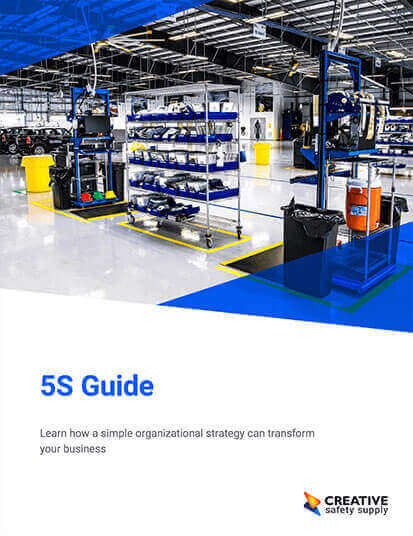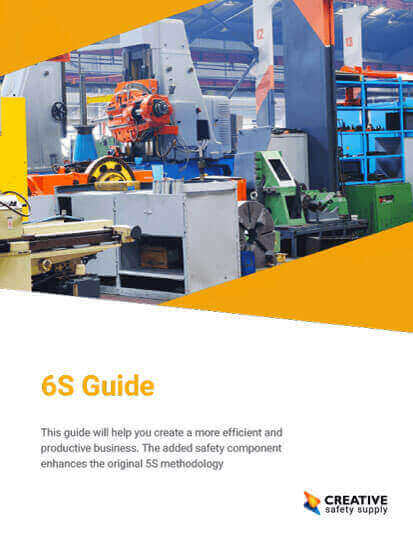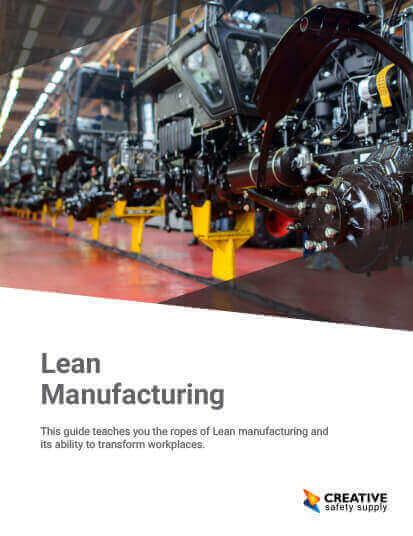The 5S Cycle
 5S is a powerful tool in the workplace and can be adapted to fit into any appropriate time scale (daily, monthly, yearly, etc.) as long as ongoing support is handled correctly. Below is an in-depth exploration of each step within the 5S process and how it can be utilized to ensure maximum effectiveness.
5S is a powerful tool in the workplace and can be adapted to fit into any appropriate time scale (daily, monthly, yearly, etc.) as long as ongoing support is handled correctly. Below is an in-depth exploration of each step within the 5S process and how it can be utilized to ensure maximum effectiveness.
1) Sort / Seiri
Sort is the first step in any 5S process. The term sort is originally derived from the Japanese word Seiri. Each step in the 5S process has an associated goal that can be specifically outlined to help guide efforts. For the step of Sort, the goal is to remove unnecessary items from the room, station, or space being organized. Furthermore, the sorting phase also aims to provide a clean slate on which to build and carry out the other four steps.
Beginning the process of Sort starts out simply, as nearly everything should be removed from the target area. Even though taking items from one space and placing them into a big pile in another space seems like it may be making a mess, this is not true. Instead, this is the opportunity to really make decisions about what needs to stay and what needs to go so actions can be immediately taken for items that are no longer used or needed.
How It Works:
Industrial bins are needed for an accurate sort. Based on the standard approach, there are three to four "bins" or sorting categories used when conducting a 5S sort.
The three or four bins are:
- Keep: These are items used frequently and essential to the operation of the workplace being sorted. If the target area is a supply room, tool shed, or another area that feeds into greater business operations, employees should be evaluated on how often they draw tools from the Sort area to utilize those items. These tools should be returned to the 5S'd area after sorting is complete.
- Remove: Items that are not needed and are simply taking up space should be placed in a bin or pile to be removed. Example items might include the following: broken or outdated tools, chemicals or components that have degraded or passed their expiration date.
- Probation: Items in this pile or bin are being evaluated for use. A specific amount of time should be set (that is appropriate to your business cycle) during which items will be evaluated to see whether they are used often enough to keep. After the probationary period, these items are either discarded or organized back into the original workspace.
- To Move: This option is talked about less, but is still an important consideration for items that may be helpful in your business. Items that are not needed often but must be on hand for times when they are required will need to be relocated. These items will eventually find new homes in other stations or rooms that make the most sense for them.
Sort Tips
- Different spaces require different sorting frequencies. For example, a workstation should be sorted to ensure tidiness of materials everyday it will be used. On the other hand, a storage or filing cabinet may only need to undergo the initial steps of 5S monthly, quarterly, or even annually.
- It is important to actively audit the sorting process of any 5S'd space to ensure accuracy and attentiveness. Sometimes, an emphasis on organization can overshadow other important areas; be sure to check in on tool calibration, supply expiration dates, and potential safety hazards while areas are undergoing audit organization.
2) Set in Order / Seiton
The second step of 5S is "Set in Order" which is derived from the Japanese term Seiton. This phase focuses on placing the items deemed essential in the Sort phase back into the workstation or area in a specific, well-organized manner. More importantly, Set in Order is truly about finding the most efficient and sensible homes for the tools and items within that area.
Every time employees have to search around for a tool to complete their jobs, time is wasted and by extension, the business loses money. Setting items in order in an intentional and planned way is essential to minimizing these types of losses.
For example, imagine the importance of well-organized tools for EMTs. They need to have their most frequently needed tools and equipment on hand and easily accessible to help save the lives of their patients. Logical organization paired with knowledge of where tools and supplies are could literally make the difference between life and death. While the stakes may not always be as high in a production facility, every loss of efficiency does bleed a business' profits out little by little.
How It Works:
A good way to begin this step is to map out the area where the tools and equipment will be returned to. During this stage, it is critical to really think about the jobs being performed in or around each station. This knowledge should be used to map out the most convenient and comfortable areas for workers to go to or reach towards. Employees' most frequently used tools should reside in easy-to-access areas with the least restrictions possible. The goal is to minimize the need for employees to repeatedly reach over and between items by placing the most frequently used tools and supplies closest to the station operator, while opting to place less utilized items in other areas.
Set in Order Tips:
- One excellent tool/technique for setting a workspace in order in an efficient manner and keeping it that way is to utilize shadow boards. Shadow boards feature outlines of tools behind or beneath the locations where they hang or sit when stored. When an item is removed from its specific location, it is easy for a worker to quickly see where to put it back because of its silhouette. Shadow boarding can be easily applied to already existing surfaces and pegboards where items are kept.
- Personalize the placement of items. Workers are individuals and what works for one may not be the most efficient option for another. In the context of setting a workspace in order, this could mean making adjustments to where items are stored if an employee working at that station frequently is particularly tall or short. In addition, another consideration is whether an employee is right or left handed. Accommodating for this can make reaching and maneuvering to get to tools easier, safer, and more efficient. Asking employees personally to get involved with decisions, or at the very least provide feedback on what organizational setups would make the most sense for day-to-day tasks, can make a big difference in levels of efficiency and improve the process.
3) Shine / Seiso
Stemming from the Japanese term Seiso is "Shine," which means to sweep or sanitize. This is the third stage of a 5S project. First and foremost, the Shine phase is basically a complete and unapologetic cleaning of the entire workstation or space. In this phase, employees should be cleaning, dusting, polishing, sweeping, and vacuuming along with anything else needed to attain perfect order.
How It Works:
- In nearly any case, a clean workplace is a safer workplace. For instance, keeping floors clear of dust and debris helps reduce the risk of trips, slips, and falls – an extremely common cause of workplace injury. A clean workplace also helps counteract any potential infections or other health hazards employees might otherwise encounter. Simply put, workplace accidents have the potential to destroy efficiency, and a good shining can help workers avoid them.
- Cleaning can be used as an inspection tool. Clear expectations are necessary for positive employee interactions and, ultimately, results. When employees know what is expected of their workspace, they are more likely to keep things in that state. Posting imagery nearby that shows the fully cleaned or "shined" state of a workspace can be a helpful way to keep this communication alive even when no one is physically present to deliver it. Furthermore, an information board can even show step-by-step instructions for how certain areas or tools are meant to be cleaned at the beginning and/or the end of a shift.
- A regular and thorough cleaning helps prevent tool and machinery degradation. Not only does this help with safety as described above, it can also ensure these items last longer. A longer natural lifespan means less costly replacement and maintenance in the future.
Shine Tips:
- Be proactive, not reactive. Cleaning should always be carried out on a schedule, not in response to a workspace that has grown too cluttered to navigate efficiently. Reactive cleaning indicates a lack of cleaning already in progress and also suggests that workers are unable or unwilling to stick with the schedule. Shine is not about cleaning up messes as they arise; instead, it is more about implementing the proper cleanliness strategies to avoid making messes in the first place.
- Workers should take turns rotating into a supervisory role in which they are tasked with ensuring that "Shine" is up to par and done in sensible ways. This team member should be responsible for working with other members of the team on their own habits. Rotating this job helps to keep everyone happy and involved, and it also may save managers and supervisors time as they will not have to constantly carry out the task themselves.
- When Shine is done properly and on schedule for a certain period of time, rewarding workers with simple incentives (pizza parties, gift certificates, awards, etc.) can be an easy way to keep the positive momentum going. This can be useful when moving forward with the remaining 5S steps.
4) Standardize / Seiketsu
Seiketsu, Japanese for "Standardize," is the fourth step in the 5S process. This stage directly connects with some of the closing tips from the "Shine" section, and that's because it builds on the idea of auditing and checking in on 5S efforts regularly. Standardization is essentially "the bridge" between Shine and the final step of 5S, Sustain. By standardizing the approach to 5S, it can ensure organizational efforts are sustained in the long run. Failing to standardize procedures can lead to work becoming sloppy over time and a loss of efficiency.
Begin to standardize 5S operations by making the process more than a word-of-mouth agreement. This is the time to implement a clear, universally understood system so that employees are certain about what they are expected to do. One excellent way to do this is to design and print out 5S audit sheets that can be used by whoever is checking an area on a given day. A checklist that asks specific questions about the work area can help ensure that processes are carried out as intended.
Some questions on the checklist may include:
- "Are all tools in their correct place on the shadow boards?"
- "Have power tools been unplugged with their cords properly stored?"
- "Are the necessary supplies in place for the next worker who will begin a shift at that station?"
5) Sustain / Shitsuke
One of the biggest concerns with standardization is that sometimes audits may come back consistently lackluster from a 5S'd area. This is a problem, but a common one that can be addressed with relative ease. In general, many times failure at this stage is due to failing to recognize one or more factors contributing to disorganization. Contributing factors may include:
- Inadequate employee training. Sometimes, it may just be that workers have not had effective or enough training about what is expected of them. This is especially common when not all workers were involved in the original 5S efforts. This situation can also arise from employee turnover, which can place new employees into a position where others would have had more training. In this case, new employees may find themselves unable to keep up due to lack of knowledge or practice.
- Lack of Time. A question to ask is, "Are current shifts and schedules allowing adequate time to complete the set 5S tasks?" Sometimes schedules along with high demands hinder the employees' abilities to complete organizational tasks after a shift. In these cases, it is important to take a step back and look into other efficiency tweaks that could allow more time for employees to complete these needed tasks.
- Lack of requested feedback. In the standardization process employee feedback should be collected and responded to in a timely and genuine manner. Employee suggestions should be taken to heart, especially if comments hint that something is not working properly. After all, it is the employees who are tasked with keeping things in order day after day.
 The final step, which is known as Sustain or Shitsuke, focuses on taking all of the previous steps of 5S, including the standardized procedures, and transforming them into ongoing habits to ensure 5S continuous improvement. Just having a basic system in place is not enough, and the existence of the Sustain step is a testament to this. When workers are required to do something new in the workspace, it will not become an automatic habit right away; it takes people time to actually form longstanding habits.
The final step, which is known as Sustain or Shitsuke, focuses on taking all of the previous steps of 5S, including the standardized procedures, and transforming them into ongoing habits to ensure 5S continuous improvement. Just having a basic system in place is not enough, and the existence of the Sustain step is a testament to this. When workers are required to do something new in the workspace, it will not become an automatic habit right away; it takes people time to actually form longstanding habits.
How It Works:
- Demonstrate. Anything expected of workers should be demonstrated correctly by a trained and knowledgeable professional. This is the portion where workers gain an understanding of what actually needs to be done.
- Supervised undertakings. Employees need to be worked with closely so they know what is expected. In addition, employees should be monitored through their first few attempts to make sure the daily 5S habits that are being formed are the exact habits needed and desired. Workers shouldn't be coddled through this. Mistakes should be corrected.
- Periodic check-ins. After the initial training, it is important to stay vigilant by utilizing the auditing techniques established in the standardizing step to regularly ensure that things are running smoothly. Having employees learn to properly do these checks can be helpful for positive habit forming as well.
- Make changes as necessary. Sometimes continued undesired behavior or undesired results come about as a consequence of a faulty system. If this is the case, find the fault in the original setup and correct it as necessary.
Sustain Tips:
New Employee Training
When existing employees help train new employees, it helps refresh the tactics and practices of 5S.
- When a new employee joins a team that uses 5S, one of the best things to do is let current employees carry out the new employee's training. Teaching someone else how to accomplish a task requires one to evaluate his or her own knowledge, and workers can easily spot gaps that they may have questions about. Doing this also helps reinforce the ideas they are teaching, especially if workers have grown sloppy over time or deviated from the original expectations.
- Measure, don't just guess. Sustaining is about making adequate progress. The ultimate goal of 5S is to increase efficiency. The actual organizational steps taken on the way are components of this goal and shouldn't overshadow the larger endeavor. It is imperative to keep accurate tabs on whether or not the 5S effort has helped workers cut down on production times, accident rates, missing equipment costs, etc. over time. Use actual numbers and do not overlook the facts, even if they are not as impressive as hoped for.
- Properly sustaining 5S is about carrying out the task or concept time and time again until it becomes second nature. This can be a frustrating phase for both managers and employees, so it is important to ensure communication is open, factual, and constructive, while being free of accusations.
Executing all 5 Steps
Understanding and implementing the five steps of 5S—Sort, Set in Order, Shine, Standardize, and Sustain—can significantly improve workplace efficiency, safety, and organization. Each step builds upon the previous one, creating a structured approach that reduces waste, enhances productivity, and fosters a culture of continuous improvement. However, the true success of 5S lies in consistency and commitment; it is not just a one-time initiative but an ongoing process that requires engagement from all levels of an organization. When properly maintained, 5S becomes more than just a methodology—it becomes a way of working that drives long-term operational excellence.
Similar Articles
- 6S: Safety
- 5S System
- The 5S System [Lean Manufacturing Methodology]
- 5S Methodology
- Understanding The 5S Methodology Implementation
- Implementing 5S | Tools and Training
- Lean Safety | Understanding the Lean 6S Methodology
- Floor Marking For 5S
- 10 Essential Steps for Electrical Safety
- How to Implement 5S in an Organization



